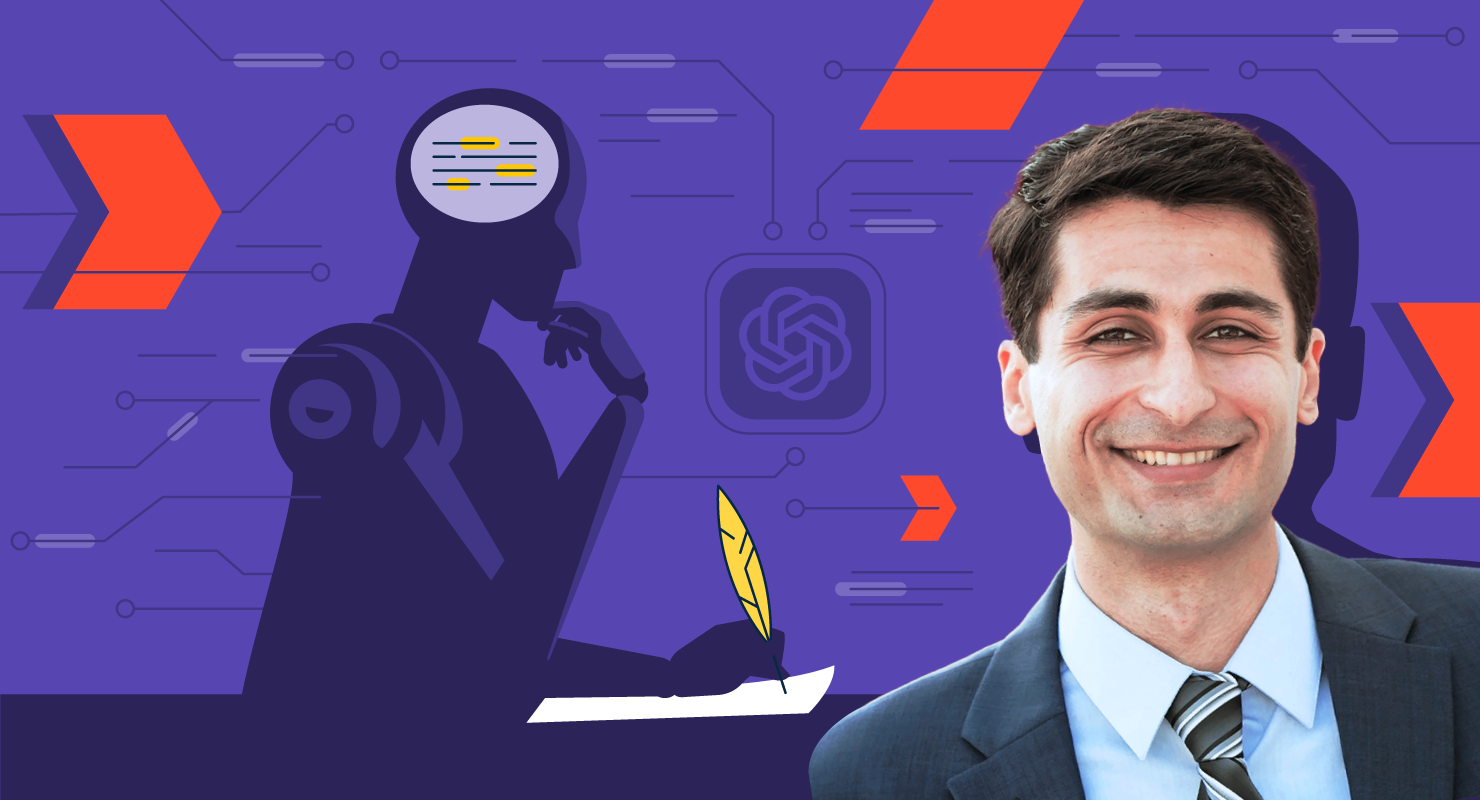July 25, 2023
.png?width=400&height=150&name=g2-leadership-Behrang_Asadi_V1%20(1).png) by Behrang Asadi / July 25, 2023
by Behrang Asadi / July 25, 2023

Generative AI, synthetic media, and large language models (LLMs) are trending in the business world today. While people still suspect its reliability and ethics, a handful of entities have integrated it into their tech stack.
Through the advent of generative AI, we are now able to simulate human thoughts, recognize commands, and solve multiple issues at the same time. Across retail, e-commerce, automotive, and tech, decision-makers are switching to generative AI software like ChatGPT to reduce research efforts, provide up-to-date and accurate information and offer human-like conversational experience. Whether you are dealing with academic queries, creative writing, problem-solving, or are seeking a meaningful conversation, ChatGPT lends a virtual hand.
ChatGPT stands for Chat Generative Pre-trained Transformer, an LLM used to understand the text and respond to questions, complete sentences, or even write brand new text. ChatGPT understands prolonged forms of content like essays, letters, articles, and research reports.
Basically, LLM is a mathematical model trained on large amounts of text from the internet. ChatGPT is a specific LLM that studies existing datasets and uses the information to generate text.
ChatGPT runs on the trinity of learning from a huge volume of textual data, receiving commands or questions from a human, and generating responses based on such guidelines.
When a user talks to ChatGPT by sending a piece of text, aka a prompt, an underlying AI model takes the prompt as input, understands and interprets what the user means, and replies accordingly. In order to do that, ChatGPT follows a mathematical modeling approach known as artificial neural networks (ANN).
Artificial neural networks are inspired by how the human brain works. Like the human brain, messages, or in this case, texts, are transported and transformed through layers of neurons.
In ChatGPT, we use this mathematical modeling approach to learn the parameters of the large language model. This is done by passing a large amount of text through a model structure to form a large language model. This process is referred to as training. Once the model is trained, it’s ready to be used with several applications.
The resulting trained LLM is the core of ChatGPT. Whenever a user chats with ChatGPT, every piece of text goes through the pre-trained AI model to understand the meaning and intent, and in return, the AI model starts to generate a response based on the user's prompt and the huge amount of text that it’s already seen in the training dataset.
Mathematically speaking, when a text prompt goes to ChatGPT, the underlying AI model first translates the prompt into a series of probability distributions that represent how the words are sequenced. Based on the mathematical representation of the prompt, the model responds using the info it already learned during the training phase.
Prompt engineering is a concept in LLMs (and more broadly in NLP) that refers to refining input to generate better, more relevant answers. Prompt engineering can significantly improve the responses generated by LLMs. In general, more specific prompts lead to more customized and relevant answers from ChatGPT.
Example of a ChatGPT prompt:
If we ask ChatGPT, “What is the best car to drive?”, it could hypothetically respond with a Ferrari. But if I say my budget is limited to $20,000, it will answer with a more relevant recommendation while keeping in mind its earlier recommendations and my feedback.
OpenAI GPT chat models are available through two different methods.
The first is through the existing application's graphical user interface (GUI). You can create an online account at the OpenAI website. After that, you can access the ChatGPT app through the same website (with a free trial for GPT-3 version). Then, head over to chat.openai.com to start writing prompts and receiving responses.
The second method is through application programming interfaces (API). To use a ChatGPT API, follow the same steps to create an account. Keep reading to learn more about how API keys and ChatGPT collaborate.
Developers require an API key to access ChatGPT API. To get one, register on OpenAI’s official website and select view API keys.
What is an API key?
"An application programming interface key (API Key) is a string of code used as a security measure to identify a user, authenticate a communication, and perform a command between a user and an application."
Here’s the step-by-step guide:
Source: Open AI
Once you create your API key, you can use that to access GPT models in your applications.
Since ChatGPT is currently free and easily accessible, hundreds of thousands of people use it every day. Depending on the type of OpenAI service agreement used, when too many people try to access ChatGPT, its services may halt and cause errors. In scenarios like that, you might see an error code with the message “ChatGPT is at capacity right now”.
%20(6)-png.png?width=600&height=300&name=Copy%20of%20Process%20(5)%20(6)-png.png)
OpenAI can detect whether or not its tool has generated a certain piece of text. The tool can also help determine if a text is generated by a large language model.
OpenAI has gone on a limb and admitted that its AI classifiers aren’t very accurate. Sometimes the tool classifies a text as AI-generated even when it’s actually written by a human. These inaccurate classifications have called into question the reliability of OpenAI’s text classifier.
Here are a few examples of ChatGPT detection tools:
A text could be machine/AI-generated but mislabeled as human-generated or vice versa. Keep in mind that editing AI-generated text can significantly impact performance or accuracy of detection tools.
ChatGPT can’t replace writers, but it can help them be more efficient and creative. The following are just a few examples of several advantages of ChatGPT and ChatGPT Plus.
One of the well-known limitations of LLMs in general, and Chat GPT in particular, is hallucination. Hallucination refers to specious responses that may seem logical but are factually incorrect.
These outputs often emerge from algorithmic biases, lack of data quality, and real-world restrictions. Sometimes, it also happens as a result of overfitting, which makes the model contrive information that is just not accurate.
The prominence of ChatGPT has caused major ripples in the content industry. Creators are looking to capitalize on generative AI buzz from the start. In the near future, AI content producers will be able to use reinforcement learning with human feedback, that will improve the quality of synthetic media production.
While generative AI is still in its nascent stage, it has surely been an eye-opening trigger for businesses. Organizations are now looking to AI-enabled tools to both improve their operations and develop better products to spring ahead of competition. AI has benchmarked new ways of working, collaborating, and brainstorming among workforces, and this phenomenon is only set to grow.
Slowly, the newly launched GPT series of models, will infuse self-aware and advanced reasoning capabilities in AI models with stream-of-thought prompt engineering that can solve multiple problems simultaneously.
For now, ChatGPT is free. The new subscription plan, ChatGPT Plus, will be available for $20 a month.
By using advanced natural language processing and data analysis abilities, ChatGPT passed a number of competitive exams, like the bar exam for law school and the MBA exams for the Wharton School of the University of Pennsylvania.
ChatGPT plugins, like AskGPT, are extensions you can pair with the AI chatbot to expand its capabilities. It connects ChatGPT to third-party applications and allows ChatGPT to interact with APIs defined by developers, which enhances its capability. Currently, a ChatGPT Plus subscription is required to access plugins.
The basic task of ChatGPT is to make content, summarize text, debug code, and solve problems in response to text-based prompts. Users turn to it to improve chatbot transcripts, marketing content creation, and customer query management systems.
Owned by Google Inc, Bard is powered by language models for dialogue applications (LaMDA). While ChatGPT focuses on long-form content, Bard responds with more accurate output. It interprets user intent better, and it produces highly coherent results. Google uses Bard to optimize its search algorithm and to help out with self-assist chatbots that take care of consumer queries.
GPT-4 comes closer to generating human-level content for work like articles, stories, narratives, scripts, and song lyrics. This advanced AI model has 170 trillion parameters that can generate up to 25,000 words. With a lower hallucination rate, it’s become the ultimate tool for critical writing tasks.
ChatGPT was developed by OpenAI and launched on November 30th, 2022.
You can use the ChatGPT app on an iPhone the same way as you do on your web browser. The user interface may be slightly different, but it’s still easy. To submit a prompt, tap on the text field at the bottom of the screen.
Keep in mind that your chats might not be 100% private because they might be accessible to OpenAI. You can disable chat history in ChatGPT like so: Login > Account Settings > Settings > Show Data Controls > Chat History and Training > Turn the toggle off.
While the underlying engine of ChatGPT seems complicated, it’s driven a lot of businesses to build their own language generation apps, personal assistants, code editors, and customized chatbots.
GPT 3 has already been trained on 570 gigabytes of text data – a huge portion of public web data. This revelation has put artificial intelligence on the fast track of augmented writing.
We have a lot of surprises and perhaps some disappointments coming around the bend. As forward-thinking professionals, our focus should be on working with AI to maintain our current pace so we never fall behind.
Curious how ChatGPT compares to other leading AI platforms? Explore the best generative AI tools to see how today’s top models stack up in creativity, usability, and real-world performance.
Behrang Asadi is the VP of Data Science and Engineering at G2. He is a seasoned leader in the field of Data Science and Engineering, with over a decade of experience across various industries, including financial services, technology, insurance, manufacturing, and big data consulting. He also holds a PhD in engineering from the University of California, San Diego. His research publications have been referenced in several high-impact academic journals and conference proceedings, solidifying his contributions to the field. In addition to his academic achievements, Behrang is a member of the advisory council for the Harvard Business Review. This role highlights his ability to translate complex technical concepts into actionable strategies for business growth and success. Beyond his professional pursuits, Behrang possesses a passion for music. In his free time, he indulges in playing the piano.
What is DALL-E? DALL-E (stylized as DALL.E) is a generative artificial intelligence (AI) tool...
 by Soundarya Jayaraman
by Soundarya Jayaraman
From relying on wordsmiths to embracing AI automation, content creation has evolved beyond...
.png) by Shreya Mattoo
by Shreya Mattoo
Generative AI is an artificial intelligence (AI) technique that uses deep learning and natural...
.png) by Shreya Mattoo
by Shreya Mattoo
What is DALL-E? DALL-E (stylized as DALL.E) is a generative artificial intelligence (AI) tool...
 by Soundarya Jayaraman
by Soundarya Jayaraman
From relying on wordsmiths to embracing AI automation, content creation has evolved beyond...
.png) by Shreya Mattoo
by Shreya Mattoo


